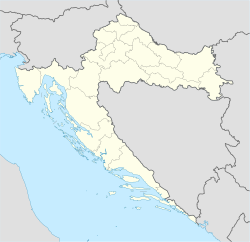
Back Rijeka Afrikaans رييكا Arabic رييكا ARZ Rijeka AST Riyeka Azerbaijani Рыека Byelorussian Рыека BE-X-OLD Риека Bulgarian Rijeka Breton Rijeka (grad) BS
Rijeka / Fiume
| |
|---|---|
| City of Rijeka Grad Rijeka | |
 | |
| Coordinates: 45°19′38″N 14°26′28″E / 45.32722°N 14.44111°E | |
| Country | |
| County | Primorje-Gorski Kotar |
| Government | |
| • Mayor | Marko Filipović (SDP) |
| • City Council | 31 members |
| • Electoral district | VIII |
| Area | |
• City | 43.4 km2 (16.8 sq mi) |
| • Metro | 3,200 km2 (1,200 sq mi) |
| Elevation | 0–499 m (0–1,637 ft) |
| Population (2021)[2] | |
• City | 107,964 |
| • Density | 2,500/km2 (6,400/sq mi) |
| • Metro | 219,325 |
| Time zone | UTC+1 (CET) |
| • Summer (DST) | UTC+2 (CEST) |
| Postal code | 51000 |
| Area code | 051 |
| Vehicle registration | RI |
| Patron saints | St. Vitus |
| Website | www |
Rijeka (Croatian: [rijěːka] ⓘ[a]; Fiume ([ˈfjuːme] in Italian and in Fiuman Venetian) is the principal seaport and the third-largest city in Croatia. It is located in Primorje-Gorski Kotar County on Kvarner Bay, an inlet of the Adriatic Sea and in 2021 had a population of 107,964 inhabitants.[5] Historically, because of its strategic position and its excellent deep-water port, the city was fiercely contested, especially between the Holy Roman Empire, Venice, Italy and Yugoslavia, changing rulers and demographics many times over centuries. According to the 2011 census data, 85% of its citizens are Croats, along with small numbers of Serbs, Bosniaks and Italians.
Rijeka is the main city and county seat of the Primorje-Gorski Kotar County. The city's economy largely depends on shipbuilding (shipyards "3. Maj" and "Viktor Lenac Shipyard") and maritime transport. Rijeka hosts the Croatian National Theatre Ivan pl. Zajc, first built in 1765, as well as the University of Rijeka, founded in 1973 but with roots dating back to 1632 and the local Jesuit School of Theology.[6]
Linguistically, apart from Croatian and Italian, the city is home to its own unique dialect of the Venetian language, Fiuman, with an estimated 20,000 speakers among the local Italians, Croats and other minorities.[citation needed] Historically, Fiuman served as the main lingua franca among the many ethnicities inhabiting the multi-ethnic port city. In certain suburbs of the modern extended municipality the autochthonous population still speaks Chakavian, a dialect of Croatian.
In 2016, Rijeka was selected as the European Capital of Culture for 2020, alongside Galway, Ireland.[7]
- ^ Register of spatial units of the State Geodetic Administration of the Republic of Croatia. Wikidata Q119585703.
- ^ "Population by Age and Sex, by Settlements" (xlsx). Census of Population, Households and Dwellings in 2021. Zagreb: Croatian Bureau of Statistics. 2022.
- ^ Wells, John C. (2008). Longman Pronunciation Dictionary (3rd ed.). Longman. ISBN 978-1-4058-8118-0.
- ^ Roach, Peter (2011). Cambridge English Pronouncing Dictionary (18th ed.). Cambridge: Cambridge University Press. ISBN 978-0-521-15253-2.
- ^ Cite error: The named reference
:0was invoked but never defined (see the help page). - ^ "From The Beginning..." University of Rijeka. Archived from the original on 19 November 2015. Retrieved 11 September 2015.
- ^ "Croatian city Rijeka wins European Capital of Culture in 2020". Shanghai Daily. Archived from the original on 8 April 2016. Retrieved 25 March 2016.
Cite error: There are <ref group=lower-alpha> tags or {{efn}} templates on this page, but the references will not show without a {{reflist|group=lower-alpha}} template or {{notelist}} template (see the help page).
© MMXXIII Rich X Search. We shall prevail. All rights reserved. Rich X Search








